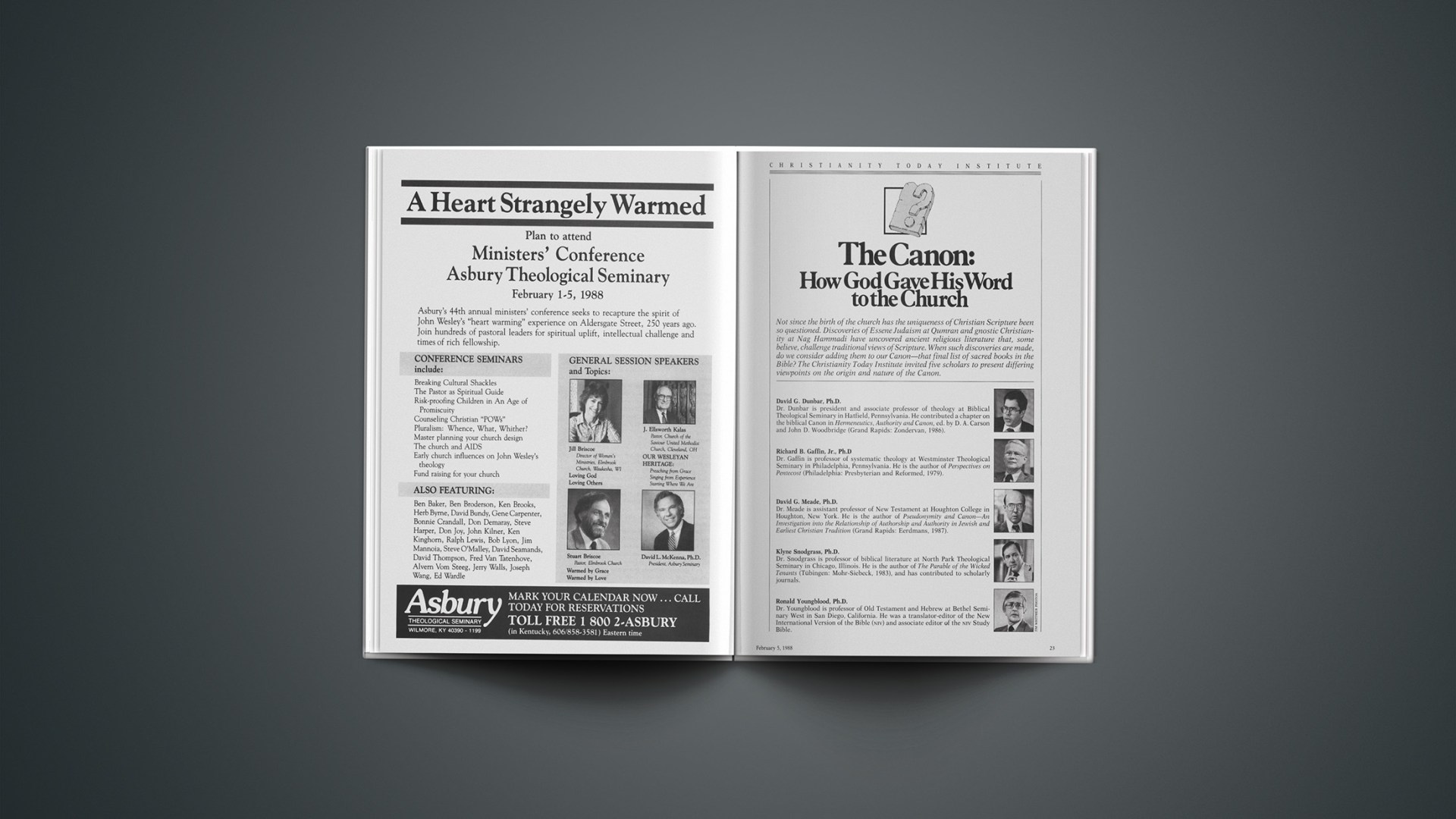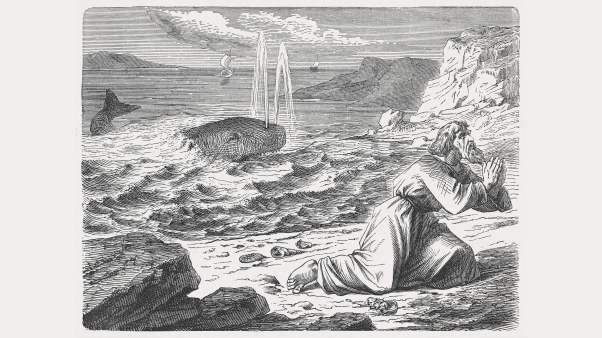“Isn’t it great that God has given us some additional sayings of Jesus!” said Jim to the other members of his Bible-study group. “Listen to this: ‘Jesus said to them, “Give to Caesar what is Caesar’s, give to God what is God’s, and give to me what is mine.” ’ ”
“Wait a minute,” Cindy responded. “My Bible leaves out that last clause.”
“But that’s just the point,” Jim insisted. “Matthew, Mark, and Luke don’t include it, but it’s right here in the Gospel of Thomas, an extra New Testament book found in Egypt over 40 years ago!”
Given the discovery of 49 ancient religious books (including the Gospel of Thomas) near Nag Hammadi in Upper Egypt in 1945, why shouldn’t Jim believe we now have additional authentic information about Jesus’ words and deeds? And given the 1947 discovery of hundreds of manuscripts near the northwest shore of the Dead Sea, shouldn’t we at least consider the possibility of expanding the Old Testament?
These questions, and others like them, relate to the process of establishing the Canon of Holy Scripture.
The Measure Of Scripture
Actually, the word canon comes from the Greek kanon, which in turn comes from the Hebrew qaneh (reed, measuring rod). As is well known, the Old Testament canon consists of 39 books. It derives ultimately from the three-part Hebrew canon of Judaism, which includes the same 39 books but counts and arranges them differently (thus explaining references to a 22-or 24-book canon). These three parts—the Torah (law, instruction), Nevi’im (prophets), and Ketuvim (writings)—are referred to by the acronym of Tanak.
Ancient Jewish witnesses, beginning with the Old Testament itself, provide ample and formidable testimony to the origins and development of the Canon among God’s people. Exodus 24:7; Joshua 8:30–31; 2 Kings 14:6; 22:11–13; 23:3; Nehemiah 8:8–9, 14–17; 10:28–39; 13:1–3 all take for granted a written Torah, in whole or in part, that has divine authority and is therefore to be obeyed. During the exile, the prophet Daniel refers to a portion of the writings of Jeremiah, his older contemporary, as among “the Scriptures” (Dan. 9:2). And after the exile, the formula “As it is written” (or its equivalent) began to gain prominence (2 Chron. 30:5, 18; Ezra 3:4; Neh. 8:15). It is clear, then, that substantial sections of the books later gathered as the Tanak were early recognized as authoritative.
In about 190 B.C. Ben Sira, the last Palestinian Jewish author known by name until the New Testament period, wrote an apocryphal (“hidden, esoteric”) book of wisdom later called Ecclesiasticus. Parts of this book hint that most of the books of the Torah and Nevi’im were recognized as canonical by that time (although none of the Minor Prophets is mentioned by name). In addition, Ecclesiasticus 39:1 mentions “the law of the Most High …, the wisdom of all the ancients, and … prophecies,” which may have paved the way for the later threefold division of the Hebrew canon. Ben Sira’s grandson wrote a prologue to Ecclesiasticus (about 130 B.C.) in which he gives three designations to such a division: “the law and the prophets and the others who followed after them,” “the law and the prophets and the other books of the fathers,” and “the law and the prophecies and the rest of the books.”
Whether either Ben Sira or his grandson conceived of a “canon” in the strict sense is debatable, but by the first century A.D., at the very latest, it is clear that the concept of a closed canon had been formulated and its present limits defined. Philo of Alexandria (c. 20 B.C. to C. A.D. 50) refers to “laws, and … prophets, and psalms and other books.” He further insists on the immutability of the laws of Moses and never quotes from any apocryphal work as Scripture. Jesus Christ himself, a contemporary of Philo, mentions “the Law of Moses, the Prophets and the Psalms” as ultimately finding their fulfillment in his own person (Luke 24:44).
Selecting The Books Of The Old Testament
The earliest attestation (late first century A.D.) of a 24-book Hebrew canon is the apocryphal 2 Esdras 14:38–46, where it is stated that Ezra was commanded to dictate to five scribes the contents of 94 books, of which 70 were to be read only by the wise (thus esoteric works) and 24 were to be made public (thus canonical works).
The Jewish historian Josephus (c. A.D. 37–100) was the first to distinguish explicitly what we would call “canonical” books from those we would call “noncanonical.” He refers to 22 books (probably a reduction of the 24 by combining Ruth with Judges and Lamentations with Jeremiah), and declares they were written from the time of the death of Moses to the reign of Artaxerxes (who ruled in the days of Ezra). He further states that books composed after that time are not of equal value or authority with those written earlier “because the exact succession of the prophets ceased”; and he affirms that no one has added or subtracted or changed so much as a single syllable of the earlier (canonical) books, which every Jew instinctively regards as divine commands to be obeyed completely. Allowing for a bit of hyperbolic propagandizing, we can hardly overestimate the importance of this passage—especially when we remember that Josephus was a Pharisee writing after the destruction of Herod’s temple and who therefore represented the mainstream Judaism of his time.
Like Jesus and Philo, Josephus refers to the third section of the Canon as psalms to God and practical precepts to men. In so doing he was simply stressing the first, longest, and most important book in the list of the Ketuvim, a term first used by Gamaliel II at Jamnia. It is often asserted that at the end of the first century one or more rabbinical councils was held at Jamnia (Jabneh, north of Ashdod near the Mediterranean), where the Hebrew canon was finally established. But recent research has concluded that canonical discussions at Jamnia were limited to Ecclesiastes and the Song of Songs, that both books had circulated long since, and that Jewish (and Christian) debate about the extent of the Old Testament canon continued long afterward. Akiba ben Joseph, an influential rabbi during the Jamnia discussions, is reported to have made an impassioned plea on behalf of the Song of Songs: “The whole world is not worth the day on which the Song of Songs was given to Israel. All the Ketuvim are holy, and the Song of Songs is the holy of holies!”
Early Christian witnesses substantially confirm Jewish testimony with respect to the development of canonical understanding among devout elements of the believing community. Justin Martyr (died A.D. 164) quoted freely from the books of the Jewish canon but never from the Apocrypha. Melito of Sardis provides the earliest Christian list of Old Testament books (c. A.D. 170), omitting only Esther (whether deliberately or accidentally it is impossible to say). The learned monk Jerome (died A.D. 420) also affirmed the 22-book canon and stated in no uncertain terms that the “apocryphal” books (Jerome was the first to use the adjective to describe noncanonical works) were not divinely authoritative. Jerome’s witness is crucial because of his impressive knowledge of and expertise in the biblical languages.
Unfortunately, Augustine of Hippo (A.D. 354–430) was not as discerning, due to his unfamiliarity with Hebrew and his failure to cautiously assess the Septuagint (an early Greek translation of the Tanak). So it is not surprising that he added certain apocryphal works to the Jewish canon—an expanded canonical view accepted by the Synod of Hippo (A.D. 393) and the Third Synod of Carthage (A.D. 397) under his influence.
Interestingly enough, Augustine asserted such works were held as canonical not by the Jews but by the church. His statement flies in the face of the facts, however. Rejection of the Apocrypha and acceptance of only the 22-book (or 24-book) Old Testament canon was common among the fathers of the church. But the schizophrenic tendency among many was to hold to a strict canon theologically while using a broader “canon” devotionally and homiletically, resulting in a gradual obliteration of the distinction between Canon and Apocrypha. The most popular of the latter, often read publicly in the churches, became quasi-canonical, and for a thousand years the formidable influence of Augustine reigned supreme.
The onset of the Protestant Reformation, however, brought about a change that permanently disturbed the canonical debate. Martin Luther’s doctrine of sola Scriptura (“the Bible alone”) rejected church tradition and forced a reversion to the insistence of Jerome that only the books of the Hebrew canon possessed divine authority. After all, only they were acknowledged by Christ (Luke 11:50–51), the apocryphal works do not proclaim him, and the New Testament itself—which quotes from the Old Testament Scriptures nearly 300 times—never quotes an apocryphal book as though it were Scripture. Jesus and the apostles appealed only to the Hebrew canon, and it was the Jews alone who had been “entrusted with the very words of God” (Rom. 3:2).
At the same time, the early Reformers did not reject the Apocrypha totally and for every purpose, since centuries of use had conferred on them a semi-authoritative status. But the Catholic church, which had long held to the canonicity of the Apocrypha, decreed at the fourth sitting of the Council of Trent (April 8, 1546) that the apocryphal books (excepting only the Prayer of Manasseh and 1 and 2 Esdras) were equal in authority and canonicity to the Old Testament, and that anyone who claimed otherwise was to be declared anathema (accursed). Thus, to this day the Old Testament canon remains seven books longer in the Roman Catholic Bible than in that of the Protestants.
The New Testament Canon
Heady excitement generated by Jesus’ resurrection led inevitably to the writing and, ultimately, collection of certain apostolic books that would form an incipient Christian canon to be added to that of the Jews. Yet the contents of the New Testament—the 27 books that the spiritually sensitive members of the worldwide Christian community would come to recognize as canonical—were not established for nearly 300 years after the last New Testament book was written.
The criteria for including these books in the New Testament canon were the same as for inclusion in that of the Old—antiquity, inherent authority, and the like—but with a new wrinkle or two. Christocentricity now received paramount attention. Apostolic authorship—or, lacking that, apostolic authority—also became an indispensable condition. Just as in early Judaism when the Hebrew canon was considered closed when it was recognized that the period of classical prophecy was over, so too in early Christianity the New Testament canon was considered closed when it was eventually recognized that the divine authority resident in the apostolic writings could not be reproduced.
Ultimately, then, canonicity was based not on human decision but on divine inspiration: recognized intrinsic authority precedes canonicity. If it is possible for 1 Timothy 5:18 to quote Deuteronomy 25:4 as “Scripture,” it is equally possible for the same text to quote Luke 10:7 as “Scripture.” If authoritative prophetic texts were expected to be read aloud in Jewish synagogues (Luke 4:16–21), so also authoritative apostolic texts were expected to be read in Christian congregations (1 Cor. 14:37; Col. 4:16; 1 Thess. 5:27; Rev. 1:3,11). And if certain prophecies of Jeremiah could be referred to as part of “the Scriptures” by one of his contemporaries (Dan. 9:2), so could certain letters of Paul be classed among “the other Scriptures” by one of his contemporaries (2 Peter 3:16).
Ancient Christian witnesses concur, although at first with understandable caution. Clement of Rome (c. A.D. 96) quotes Jesus’ words in parallel with Old Testament texts and gives them equal authority, but he does not cite the New Testament with the same introductory formulae used for Old Testament citations. Ignatius of Antioch (early second century) intimates that there was a collection of Paul’s letters in his time. And Polycarp of Smyrna (c. A.D. 115), among others, recognizes certain of the apostolic letters as Scripture.
Exclusively Christian Scriptures
Efforts to form a New Testament canon received a push from an unexpected source: heretical movements that threatened Christian orthodoxy in the second century. Ironically, Marcion of Sinope (c. A.D. 140; see p. 27) was the first to provide a canon, however deficient, of exclusively Christian Scriptures. Rejecting the Old Testament outright, he included only ten Pauline letters and a drastically edited version of Luke.
Marcion’s canon triggered a vigorous response. Justin Martyr, who mentioned Marcion by name, referred to the “memoirs” of the apostles, also known as “Gospels”—the first use of the term gospel to designate a book. He pointed out that the Gospels were read in church services weekly together with “the compositions of the prophets” and quoted Old Testament and apostolic texts as equally authoritative. Although we cannot be certain as to whether Justin knew the Gospel of John, it seems likely that he did since one of his pupils, Tatian, compiled the Diatessaron (“by means of four”), the earliest harmony of the four Gospels (c. A.D. 160). Tatian’s work is significant in that he assumes the existence of but four authoritative Gospels—no more, no less. A bit later Irenaeus of Lyons (c. 178–200) “proved” that there were only four Gospels by observing that, just as there are four points of the compass and four principal winds, so also the worldwide church appropriately rests on four pillars (that is, Gospels). In addition, Irenaeus affirmed, the four living creatures in Revelation correspond to the four aspects of the person of Jesus in the gospel writers.
In 1740 the Italian historian Muratori published an incomplete manuscript that he had earlier discovered. Popularly known as the Muratorian Canon, it dates from the late second century. A few of the non-Pauline letters were omitted, but this is perhaps due to the fragmentary nature of the manuscript. It specifically rejected the writings of various heretical groups and, although it included the apocryphal book of Wisdom as well as a pseudepigraphic work called the Apocalypse of Peter, it issued a stern warning against the Shepherd of Hermas as too recent to be considered canonical. (Unfortunately, Irenaeus quoted the Shepherd with the formula “Scripture says,” indicating that Christian writings other than our 27 New Testament books were often reckoned as canonical during this period.)
Tertullian, however, insisted on apostolicity as the major criterion of canonicity. Clement was the first to clearly use the words “covenant” or “testament” in a literary sense in reference to the New Testament writings as well as to the Old Testament, and he cited the New Testament as Scripture more frequently than he did the Old.
As for Origen, he classified sacred writings into three categories: acknowledged, disputed, and spurious. He included 21 New Testament books in the first group, 6 (Hebrews, James, 2 Peter, 2 and 3 John, Jude) in the second, and various heretical “gospels” in the third. He further paved the way for eventual acceptance of the disputed works by stating that Jude, for example, though of doubtful apostolic authorship, was “full of words of heavenly grace.” The Didache, the Shepherd of Hermas, and the so-called Epistle of Barnabas he considered authoritative, but it is doubtful whether he considered any of them as fully canonical.
The earliest known recognition of the 27 books of the New Testament as alone canonical, to which nothing is to be added and from which nothing is to be subtracted, is in the list preserved by Athanasius (A.D. 367). The Synod of Hippo (A.D. 393) and the Third Synod of Carthage (A.D. 397) duly acquiesced, again probably under the influence of the redoubtable Augustine. Thus led (as we believe) by divine Providence, scholars during the latter half of the fourth century settled for all time the limits of the New Testament canon. The 27 books of Matthew through Revelation constitute that New Testament, which possesses divine authority equal to that of the Old.
Subsequent skirmishes in the battle for the New Testament continued to erupt, however. Throughout much of his life, Martin Luther (see p. 34) continued to express reservations, alternately strong and weak, about Hebrews, James, Jude, and Revelation, and to the end of his days he considered James “a right strawy epistle.” His doubts ultimately led him to suggest that the New Testament canon be narrowed (as had properly been the result with respect to the Old Testament canon, due to his attacks against the apocryphal books).
John Calvin tended to be much more moderate in his discussions of New Testament authority. For example, his opinion that 2 Peter was perhaps composed not by Peter himself (but by one of his disciples, and at his command) did not for Calvin diminish its right to be called canonical.
A Closed Canon?
Is the Canon, then—the present 66 books of the Old and New Testaments—closed? The answer is a resounding yes. The closing of the Old Testament canon probably occurred at least a century before the birth of Jesus, and the closing of the New took place in the late fourth century. No longer are we in a position to reassess the second-century process, undertaken by godly believers who were intimates of the apostles themselves. Their work ultimately resulted in what we believe to have been the divinely superintended choice of the books of the Jewish and Christian canons that constitute our Bible. The closing of the two canons and their amalgamation into one are historical watersheds that it would be presumptuous to disturb.
“All Scripture”—neither more nor less than what we have—“is God-breathed and is [therefore] useful” (2 Tim. 3:16). The Bible alone, and the Bible in its entirety, constitutes the total Canon for the church universal.
Ronald Youngblood is professor of Old Testament and Hebrew at Bethel Seminary West (San Diego, Calif.), translator-editor of the New International Version of the Bible, and associate editor of the NIV Study Bible.
Marcion
Marcion (85–160) felt the world had many flaws, chief among which were grasshoppers, crocodiles, and sex. He could not believe the Being who had created these things was good. They must have been the product of a sick mind.
Another product of a sick mind, he thought, was the Old Testament. “Look at all the lying, pillage, and killing,” he said. “Look at the favoritism: Yahweh selects a race of idolatrous schemers to be his chosen people, and calls an adulterous, murdering brigand ‘a man after my own heart.’ No,” concluded Marcion, “the one who made the world and inspired the Old Testament could not be good because Jesus himself had said ‘a good tree does not bring forth evil fruit.’ The Old Testament god may be the powerful creator, but he is not the good heavenly father Jesus proclaimed.”
Marcion’s eccentric views might not have made much of an impact except that he was a wealthy ship owner from Sinope, on the Black Sea. He presented himself to the Roman church around 140, seeking membership. He was the son of a bishop, but had been excommunicated by his own father. Nevertheless, the Roman church accepted him, perhaps influenced by his million-dollar gift. While in Rome, Marcion developed his ideas and won disciples to his views. He taught that Jesus had suddenly appeared, full grown, at the synagogue in Capernaum in A.D. 29, teaching the previously unknown existence of a good God who wanted to save men and free them from the material world. Marcion’s Jesus had opposed the work of the Old Testament God saying, “I have not come to fulfill the law but to destroy it.” This savior dissociated himself from the messiah foreseen by the prophets, proclaiming God’s universal grace and love for all humanity. True followers of this unearthly Jesus must abstain from meat and wine, live in celibacy, and expect to be martyred.
Marcion said he had learned about this Jesus by reading Paul’s epistles and the Gospel Paul wrote, which had been mistakenly assigned to Luke. Of course, during his life Paul had been opposed by the Judaizers, and Marcion claimed that, after the apostle’s death, his opponents had added pro-Jewish passages to his writings and produced the spurious Gospels of Matthew, Mark, and John. Marcion said Christians must reject the Old Testament and accept as their Bible only ten of Paul’s letters and Luke’s Gospel with all the Jewish sections removed.
When Marcion’s views became widely known, the Roman church recoiled in horror. To say that there were different Gods in the Old and New Testaments opened the door to polytheism. To deny the Old Testament cut Christianity off from its roots. To impugn the fourfold gospel and the catholic epistles was to reject the Word of God. Marcion was again excommunicated and his money returned. He became a traveling preacher and established Marcionite churches throughout the East.
Marcion thought he was recalling the church to pristine purity, purging it of Jewish corruptions. Instead, his teaching forced the church to reaffirm its commitment to the Old Testament, and to take the first steps toward the establishment of the Canon.
Historical vignettes by Charles E. White, associate professor of Christian thought and history at Spring Arbor College and author of The Beauty of Holiness.










